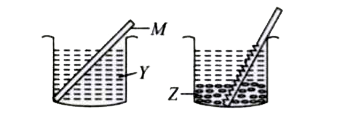A metal rod dipped into a solution containing its own ions at unit activity at 298 K is called
single electrode
half cell
metal couple
standard electrode
The correct Answer is:D
Topper's Solved these Questions
- ELECTROCHEMISTRYBook:MARVEL PUBLICATIONChapter:ELECTROCHEMISTRYExercise:Previous years Entrance Exams MCQ
Explore 55 Videos
- ELECTROCHEMISTRYBook:MARVEL PUBLICATIONChapter:ELECTROCHEMISTRYExercise:Test your Grasp
Explore 50 Videos
- D AND F BLOCK ELEMENTS Book:MARVEL PUBLICATIONChapter:D AND F BLOCK ELEMENTS Exercise:TEST YOUR GRASP
Explore 60 Videos
- GENERAL PRINCIPLES AND PROCESSES OF ISOLATION OF ELEMENTSBook:MARVEL PUBLICATIONChapter:GENERAL PRINCIPLES AND PROCESSES OF ISOLATION OF ELEMENTSExercise:Test Your Grasp
Explore 30 Videos
Similar Questions
A teacher showed demonstration of action of acids on the metals in the laboratory. After the activity was over, one naughty student took an alluminium rod. He dipped it in a bottle containing concentrated nitric acid. Later, he dipped it in a beaker containing dilute H2SO4 But, he did not find any bubbles coming out. He was surprised because he was able to see bubbles coming out when a metal rod is dipped in sulphuric acid when teacher did the experiment. He then approached the teacher and asked what is wrong with his activity. Predict the answer given by the teacher.
View SolutionA teacher showed demonstration of action of acids on the metals in the laboratory. After the activity was over, one naughty student took an alluminium rod. He dipped it in a bottle containing concentrated nitric acid. Later, he dipped it in a beaker containing dilute H2SO4 But, he did not find any bubbles coming out. He was surprised because he was able to see bubbles coming out when a metal rod is dipped in sulphuric acid when teacher did the experiment. He then approached the teacher and asked what is wrong with his activity. Predict the answer given by the teacher.
View Solution
Knowledge Check
The potential across the metal and the aqueous solution of its ions of unit activity at 298K is known as
AElectrode potentialBStandard electrode potentialCFormal electrode potentialDOxidation potentialAssertion : A metal having negative reduction potential when dipped in the solution of its own ions has a tendency to pass into solution .
Reason : Metals undergo reduction .AIf both assertion and reason are true and reason is the correct explanation of assertion.BIf both assertion and reason are true but reason is not the correct explanation of assertion.CIf assertion is true but reason is false.DIf both assertion and reason are false.Assertion : A metal having negative reduction potential when dipped in the solution of its own ions has a tendency to pass into solution .
Reason : Metals undergo reduction .AIf both assertion and reason are true and reason is the correct explanation of assertion.BIf both assertion and reason are true but reason is not the correct explanation of assertion.CIf assertion is true but reason is false.DIf both assertion and reason are false.
A metal rod M was dipped in a coloured solution Y. After some time it was observed that the metal rod starts dissolving in the solution and the solution starts fading in colour. However, a coloured precipitate Z was seen at the bottom of the beaker. M, Y and Z could be

View SolutionIron rod is dipped in concentrated HNO3 After some time the iron rod dipped in AgNO3 solution. Ag is not displace by Iron. This is because
View SolutionA metal rod M was dipped in a coloured solution Y. After some time it was observed that the metal rod starts dissolving in the solution and the solution starts fading in colour. However, a coloured precipitate Z was seen at the bottom of the beaker. M, Y and Z could be

View SolutionAssertion : When a zinc rod is dipped in a solution of copper sulphate, zinc rod dissolves partially and its surface is coated with copper metal.
Reason : This reaction is due to the presence of sulphate ions.
View SolutionWhen a metal rod M is dipped into an aqueous colourless concetrated solution of compound N, the solution turns light blue. Addition of aqueous NaCl to the blue solution gives a white precipitate O. Addition of aqueous NH3 dissolves O and gives an intense blue solution.
Q. The metal rod M is
View Solution
